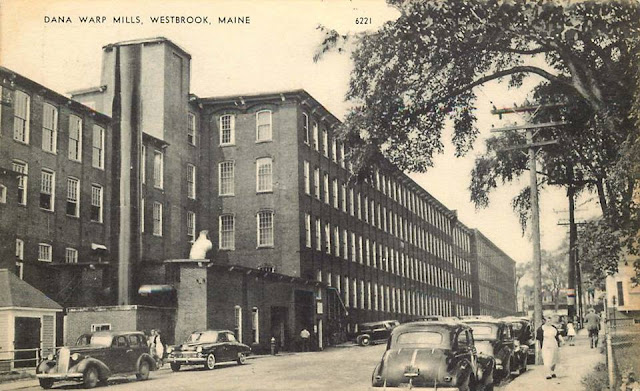The Dana Warp Mill in Westbrook, Maine, operated under the direction of Woodbury K. Dana from 1866 to 1957. By definition, warp is the cotton thread that is used for weaving textiles. My grandfather, Auguste "Gus" Albert, also founded a textiles business not as a manufacturer but as a retailer. It was incorporated in 1923 with the name, The Men's Shop. Both men became prominant members of the Westbrook business community.
Auguste Albert married Bernadette Gagnon in 1924. Auguste's father and Bernadette's parents immigrated to Westbrook from Canada to work in the mills. Many of our ancestors worked at the Dana Warp Mill. Here are a few found in city directories: Antoinette Albert (1919), Yvonne Albert (1921), Exilia Gagnon (1919 and 1921). Antionette and Yvonne were Auguste's sisters and Exilia was Bernadette's sister. In an interview in 1990, Josephine Gagnon (Auguste's sister-in-law) recalled operating machines at Dana Warp Mill working 6 am to 6 pm earning $7 a week. At the same interview, Bernadette shared that at age 15, she worked sorting paper at another mill in Westbrook, S. D. Warren.
Now more on Mr. Dana. He was born in Portland, Maine in 1840. As a young man, he took the opportunity to learn the business of manufacturing by working 12 hours a day in the Lincoln Cotton Mill in Lewiston. He also worked for a time as a card grinder at the Westbrook Manufacturing Company. Soon after, he served in the Union Army from 1863-1865.
In 1866, Mr. Dana formed a partnership with Thomas McEwen for the manufacture of cotton warps at Saccarappa Falls in Westbrook. Mr. McEwen was an inactive partner and sold out his interest a few years later. A major fire in 1893 motivated Mr. Dana to build a larger and better plant. In the archives at the Westbrook Historical Society, there is a report that speaks to a high standard and quality of product that the mill produced. I think of my grandfather again because he was also known to have a high standard for quality of product and for superior customer service as well.
 |
Woodbury K. Dana anniversary celebration, Westbrook, 1916 |
The Westbrook Board of Trade honored Mr. Dana on June 7, 1916, his 76th birthday and the 50th anniversary of the founding of the Dana Warp mill. A large military and civic parade followed. The celebration culminated with an event held that evening at the Star Theatre, which featured an orchestra, singing, slide shows and a movie reel of Westbrook scenes that featured Dana in many of the scenes. Woodbury Dana died on May 18, 1924 and is buried in Woodlawn Cemetery in Westbrook.
Credits: The first image shown in this post came from the Facebook group, Portland Maine History 1786 to Present. The source for the other photographs and for the detailed description of the 50th anniversary celebration is the Maine Memory Network. The source of the Dana Warp Mill advertisement is the Directory of Westbrook, Gorham, and Windham, 1915-16.










